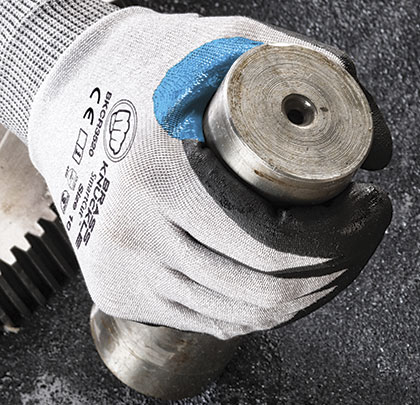There’s a new hand-protection standard in town. And it brings a global change.
In January 2016, the International Safety Equipment Association (ISEA) received American National Standards Institute (ANSI) approval for ANSI/ISEA 105-2016, the updated American National Standard for Hand Protection Classification. It’s the first revision of ANSI/ISEA 105 since 2005. The European Union is introducing a change in their hand protection standard, too.
Why the revisions? As new glove yarns, materials, and technologies have come to market, the performance of protective gloves has improved accordingly. But accurately assessing the cut-resistance levels of the improved gloves hasn’t been addressed until now. The new ANSI/ISEA 105-2016 has created a wider, more accurate range of cut-resistance performance levels for tested gloves, reported in grams of applied pressure. And all glove testing will now be performed by one specific ASTM method.
Under the previous (2005) ANSI/ISEA standard, it was challenging to select the appropriate gloves from those with the same cut level designation—particularly cut-level 4—because the gloves lumped into the cut-level 4 category actually offered varying levels of performance. The new standard’s nine gradated cut-level designations will allow users to see the shades of difference between the gloves in each level.
You will be able to tell if a glove has been tested under the new standard by the new numbering system: instead of ANSI cut levels 1 to 5, they will now be identified as A1 through A9. New levels A4, A5, and A6 represent what used to be ANSI cut level 4. The new levels A5 through A9 together represent what was the old level 5. It’s also important to be aware of the grams of cut resistance you need, so no matter which standard your gloves have been rated by, you’ll have a better idea of the protection you’re getting.
As an end user of hand protection, you will find that the new ANSI/ISEA standard provides clearer and more detailed information to help you make the decision on on which cut-resistant gloves are best for your known workplace hazards.
A WORD ABOUT BRASS KNUCKLE
Who are we to tell you all this, anyway? The Brass Knuckle® Hand Protection name may be new to you, but we’re not new to hand protection. We grew out of a partnership with one of North America’s oldest, dedicated safety product supply companies. And we want to show you why the new standard means that your job—and ours—just got easier.
One of the most important factors in choosing the right protective gloves is their cut-resistance level. It has also been one of the most difficult elements to quantify. Brass Knuckle knows that cut-resistant gloves aren’t armor. They need to protect the hands of real people doing real work. Cut-resistant gloves must be flexible, offer a sure grip for handling a variety of materials, and provide the proper level of cut protection for the job without bulk.
ANSI/ISEA 105-2016, with its revisions to cut testing and cut level classification, can now help you more accurately choose the level of protection that best ensures the safety of the glove wearer.
THE NEW STANDARD EXPLAINED
Although the use of any version of ANSI/ISEA 105 is not mandatory, it is the accepted guideline for U.S. safety managers to follow when selecting hand protection products for their employees. You may also see protective gloves rated by the EU standard EN 388 (CE) for the European and other global markets, but in the U.S., the ANSI/ISEA standard is the gold standard. The EU is also considering changes to its EN 388, with the categories sorted into six levels—but remember, the two standards are not comparable head-to-head. For cut resistance evaluation, we recommend using only ANSI/ISEA 105-2016.
Just like its predecessor, the new ANSI/ISEA 105-2016 covers testing of hand protection for cut resistance, puncture resistance, and abrasion resistance; chemical resistance; ignition resistance, vibration reduction, and other important performance characteristics. But now there’s more.
WHAT’S NEW?
The two most important features of the new standard are 1) an expansion of the cut-resistance-level scale from from the previous five cut levels to nine, and 2) the addition of a new hypodermic needle puncture resistance test, of particular value to the medical, sanitation, and recycling industries.
MEASURING UP
Cut resistance is measured and reported in grams of pressure—that is, how many grams can be applied to a straight-edge blade, under load, moving straight across a predetermined fabric before cutting through 0.8 in. (20 mm) or more. The final score in grams tells you how many grams of pressure were applied to the glove before it was cut.
The new standard also recommends a single testing method to help standardize and improve the accuracy of test results—using the ASTM F2992-15 method on Tomodynamometer (TDM-100) equipment. The previous test method (since 2005) used both the Cut Protection Performance Test (CPPT) and TDM testing.
Brass Knuckle believes the best hand protection solutions come from matching the glove construction and material to the application and then offering maximum protection along with comfort and dexterity—while ensuring it is the best quality for the price.
We focus on end users and their job-specific applications. That’s why we notice the gaps in the safety glove category—where the level of protection, fit, value, or comfort is not quite up to the job. We fill those gaps.
And ANSI/ISEA 105-2016 is another step that helps fill those gaps. We want to assure you of maximum protection, comfort, and quality with every Brass Knuckle glove you buy. We will always strive to measure up to your expectations. ■
For More Information: If you have Questions about ANSI/ISEA 105-2016 or Brass Knuckle® products, call 770.674.8930, or visit brassknuckleprotection.com.
_________________________________________________________________________
Modern Contractor Solutions – July 2016
Did you enjoy this article?
Subscribe to the FREE Digital Edition of Modern Contractor Solutions magazine.

Upping the Standard


